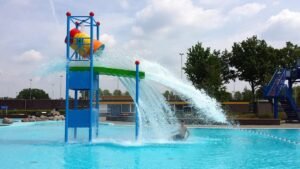The Ultimate Checklist for Detecting and Repairing Pool Leaks in Dubai
Dubai’s hot climate makes swimming pools a cherished oasis for many homeowners, property investors, and business owners. However, maintaining a pool involves vigilance against issues like leaks that can lead to significant water loss and costly repairs. In this blog post, we present The Ultimate Checklist for Detecting and Repairing Pool Leaks, ensuring your oasis remains a refreshing retreat.
Why Pool Leak Detection is Crucial
Pool leaks are not just an inconvenience. They can lead to:
- Increased Water Bills: Excessive water loss directly affects your monthly expenses.
- Structural Damage: Continuous leaks can weaken the pool structure and surrounding areas.
- Unpleasant Environment: Puddles and dampness can create a breeding ground for pests and mold.
In Dubai’s competitive real estate market, maintaining your pool also preserves property value, making leak detection even more critical.
Signs of a Potential Pool Leak
Detecting a pool leak early can save you time, money, and hassle. Here are some common signs to watch for:
-
Unexplained Water Loss:
- If you notice water levels dropping significantly (more than 1-2 inches a week), it’s time to investigate.
-
Frequent Refilling:
- If you’re refilling your pool more than usual, this is a strong indication of a leak.
-
Wet Spots Around the Pool:
- Observe the landscape around the pool. Puddles of water may indicate a leak in the underground plumbing.
-
Cracks and Damage:
- Check for cracks in the pool’s surface or around the foundation that could be exacerbated by leaking water.
-
Increased Algae Growth:
- Excessive water can lead to increased algae, making maintenance more challenging.
- Unusual Changes in Water Chemistry:
- Regularly monitor the pool chemical balance; drastic changes can signify water loss.
Step-by-Step Pool Leak Detection Checklist
Now that you know the signs, it is time to take action. Follow this comprehensive checklist for effective leak detection:
1. Conduct a Visual Inspection
-
Surface Examination:
- Inspect the pool surface for cracks, chips, or other damages.
- Check skimmer and light fixtures for seal integrity.
- Surrounding Area Check:
- Look for wet spots or excessive greenery around the pool deck.
2. Perform the Bucket Test
This simple test can help determine if the water loss is due to evaporation or a leak.
- Materials Needed: A bucket, a marker, and water.
- Step 1: Fill a bucket with water and mark the water level inside the bucket and at the water level of the pool.
- Step 2: Place the bucket on the pool steps and wait 24 hours.
- Step 3: Check the levels again. If the pool’s water level dropped significantly more than the water level in the bucket, you likely have a leak.
3. Inspect Pool Equipment
-
Filter and Pump:
- Ensure there are no visible leaks in your pump or filter system. Inspect hoses and fittings.
- Heater and Chlorinator:
- Check these components for leaks as well.
4. Check for Plumbing Issues
-
Underground Plumbing:
- Leaks may not always be visible. If you have an automatic cleaner or a water feature, inspect those connections for leaks.
- Check Valves:
- Look for cracks and ensure valves are operating correctly.
5. Water Loss Analysis
-
Post Rainfall:
- If water levels drop even after heavy rain, this could indicate a leak.
- Monitor Water Chemistry:
- If you’re experiencing sudden changes in pH or alkalinity, it could be linked to a leak.
Repairing Pool Leaks: Your Next Steps
Once you’ve confirmed the presence of a leak, the next step is to carry out repairs. Here’s how to tackle it:
1. Identify the Source
-
Localized Leak: Often, leaks can be found in certain areas, like pool walls or equipment. Focus on these sections first.
- Full System Check: In some cases, a professional inspection may be necessary to identify hidden leaks.
2. DIY Repair Options
If you’re handy, you might consider some DIY fixes:
-
Crack Sealing:
- Use pool patching kits to mend small cracks. Follow the manufacturer’s instructions carefully for the best results.
- Sealant Application:
- For larger leaks, apply a waterproof sealant on tile edges and fittings.
3. Call the Professionals
Sometimes, leaks can be more severe than they appear. At Dream Floor Landscaping Services, our expert team is equipped to handle all types of pool repairs—from minor adjustments to complete overhauls.
Contact us at: +971563787002 for professional assistance.
We provide services across Dubai and Emirates Hills as well as popular areas such as Palm Jumeirah, Meadows, Springs, Jumeirah Islands, Jumeirah Park, Jumeirah Golf Estates, Arabian Ranches, Victory Heights, Al Furjan, Green Community, Jumeirah Village Circle, Jumeirah Village Triangle, Al Barsha, Umm Suqeim, and more.
Preventive Measures for Pool Leak Protection
Once you repair the leaks, take preventive measures to reduce the chances of future leaks:
-
Regular Maintenance:
- Schedule routine inspections to catch early signs of wear and tear.
-
Quality Equipment:
- Invest in high-quality materials and pool systems that hold up against the harsh climate of Dubai.
-
Proper Installation:
- Have pools installed and maintained by professionals experienced with local conditions.
- Water Testing:
- Regularly test your pool water to keep chemical levels balanced, which helps prevent damage to pool surfaces.
Conclusion
Keeping your pool in top shape means staying alert to issues like leaks. By following The Ultimate Checklist for Detecting and Repairing Pool Leaks, homeowners and property investors in Dubai can ensure that their aquatic retreats remain a source of pleasure rather than a source of problems. If you suspect a pool leak, don’t hesitate—act quickly, and should you need expert help, contact Dream Floor Landscaping Services at +971563787002. Enjoy a beautiful, leak-free pool all year round!
For ongoing insights and resources about pool maintenance and landscaping in Dubai, subscribe to our blog. Your perfect pool is just a few steps away!





